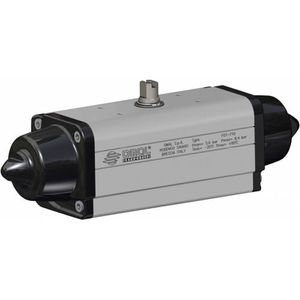

- Products
- Catalogs
- News & Trends
- Exhibitions
Pneumatic valve actuator DA seriesrotarypistondirect-drive
Add to favorites
Compare this product
Characteristics
- Type
- pneumatic
- Movement
- rotary
- Technology
- piston, direct-drive
- Configuration
- double-acting
- Other characteristics
- aluminum, ATEX, NAMUR
- Torque
Max.: 8,000 Nm
(5,900.5 ft.lb)Min.: 8 Nm
(5.9 ft.lb)- Pressure
6 bar, 7 bar, 8 bar
(87 psi, 101.5 psi, 116 psi)- Ambient temperature
Max.: 150 °C
(302 °F)Min.: -20 °C
(-4 °F)- Rotation angle
92 °
Description
1.Energized and self-lubricated strips
Less friction between piston and cylinder
It prevents the bonding of the seal to the cylinder even after long periods of inactivity
2.Slots, bushes and pins made by steel with hardness higher than 50 HRC
Higher resistance to the forces inside the actuator
3.Rolling friction between piston and slot
Less friction
4.Scotch yoke with rolling friction (transforming rotary motion into linear motion using piston and shaft without teeths/gears)
Reduced friction between piston and shaft with consequently less wear on the relevant parts
Empowered Breakaway Torque (BTO & BTC)
Smaller volume/size than rack and pinion actuators (with the same torque) therefore less space required for installation
Less weight than the rack and pinion (-30% kg / Nm), with consequent savings on the construction sizing of the plant/equipment
Lower air consumption compared to the rack and pinion actuators (-40% air cm3/Nm for Double Acting and -20% air cm3/Nm for Spring Return) therefore less load on the compressor or the possibility of using a smaller compressor's size.
5.Rolled cylinder
Less wear of the energized ties thanks to the low roughness of the surface (0.15 micron Ra)
From sizes bigger than DAN15, NAMUR interface for solenoid valve is already integrated.
No need for extra plate.
100% in- house manufacturing process technology
Maximum control and accuracy in all the stages of the manufacturing process
Installation is allowed in a potential explosive environment
Guarantee of the high level of functional safety.
Catalogs
Related Searches
- Valve
- Hand valve
- Control valve
- Stainless steel valve
- Ball valve
- Water valve
- Pneumatic valve
- Threaded valve
- Valve with flange
- Regulating valve
- Stop valve
- Lever control valve
- ISO valve
- Biogas valve
- Pneumatically-operated valve
- Butterfly valve
- Valve for the chemical industry
- Valve for industrial applications
- Oil valve
- Nickel-plated brass valve
*Prices are pre-tax. They exclude delivery charges and customs duties and do not include additional charges for installation or activation options. Prices are indicative only and may vary by country, with changes to the cost of raw materials and exchange rates.




